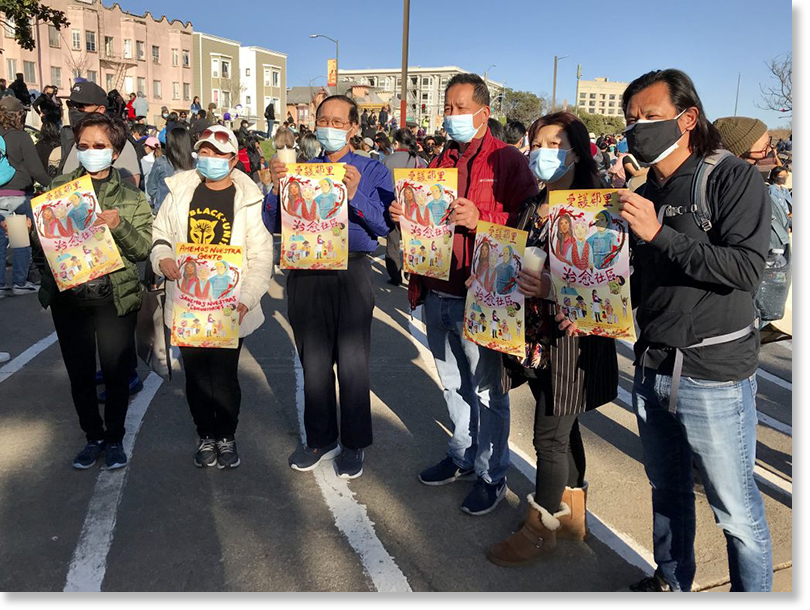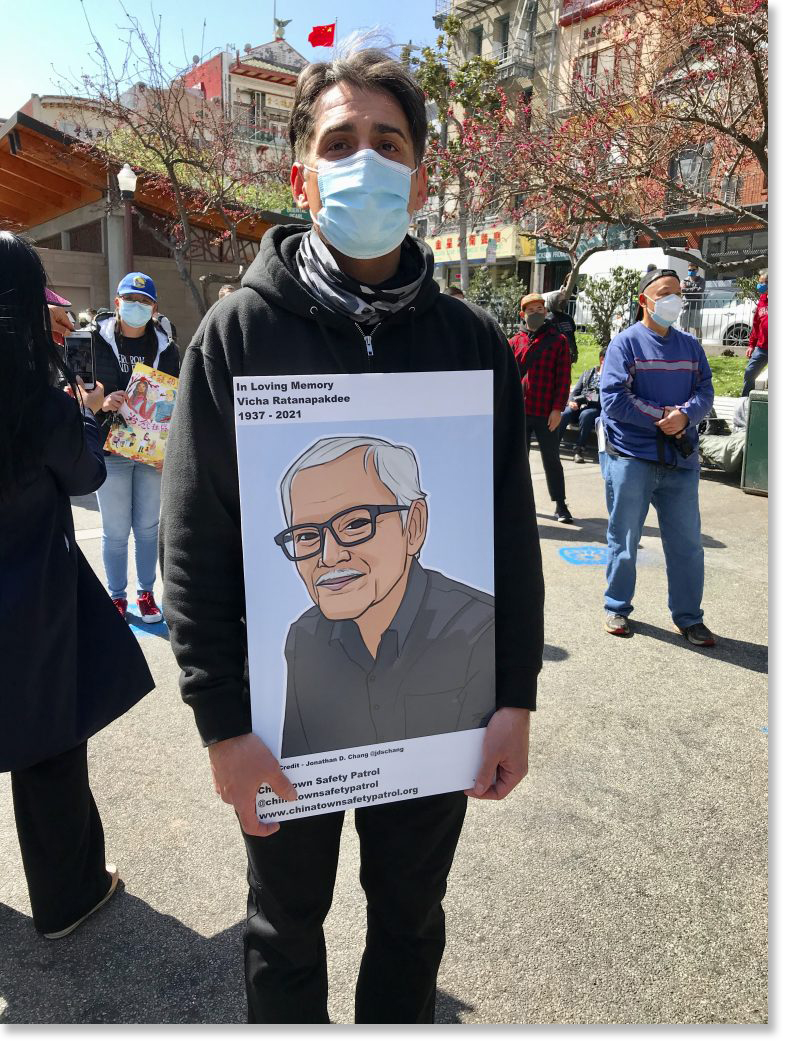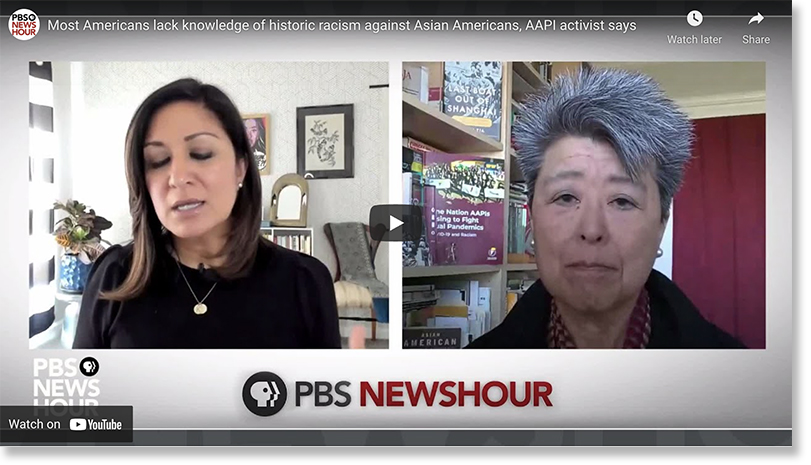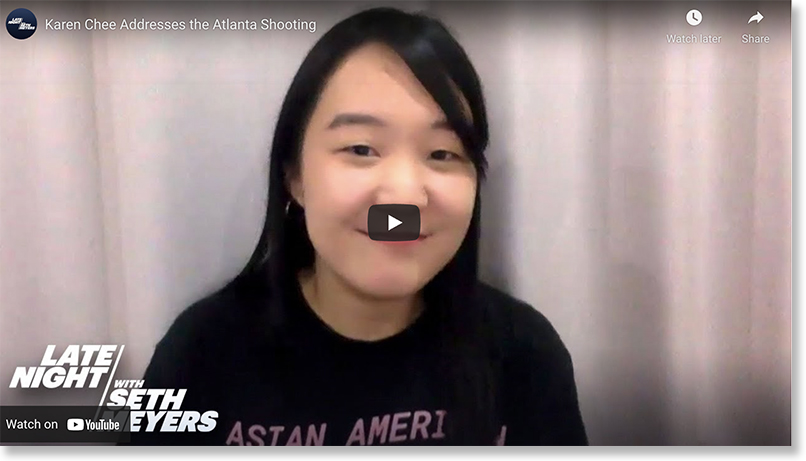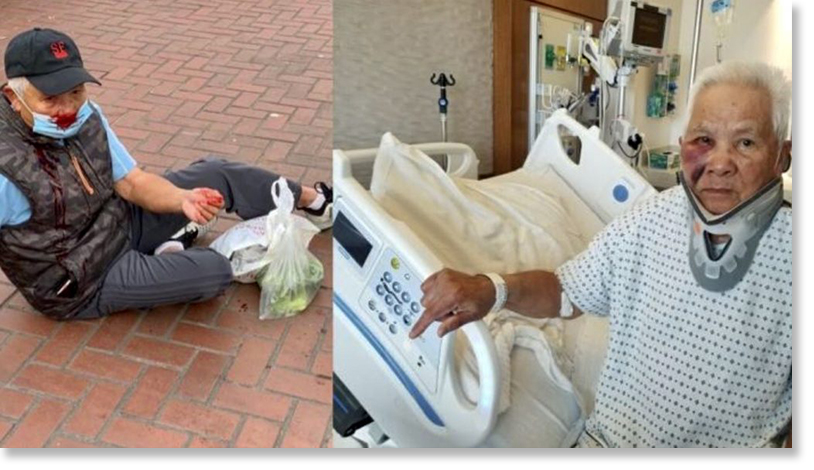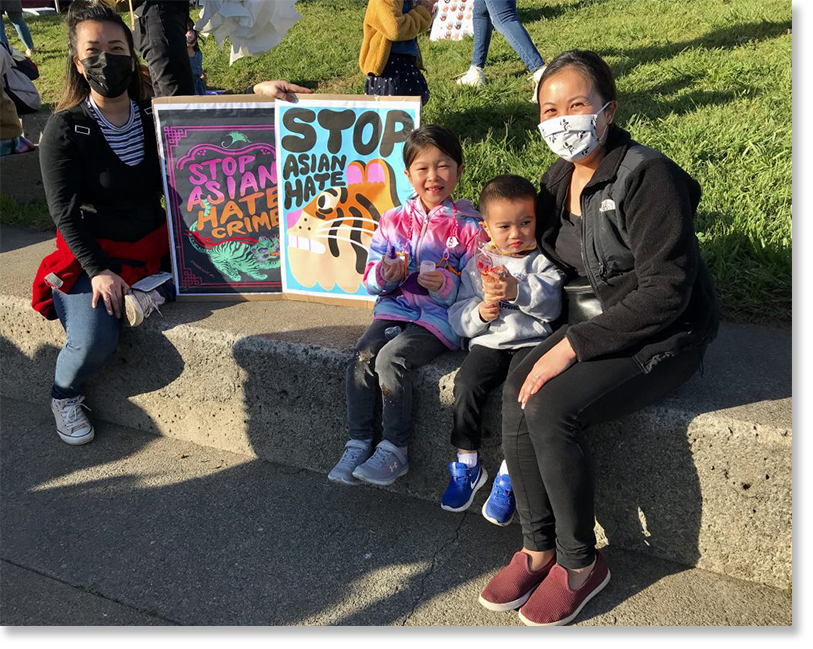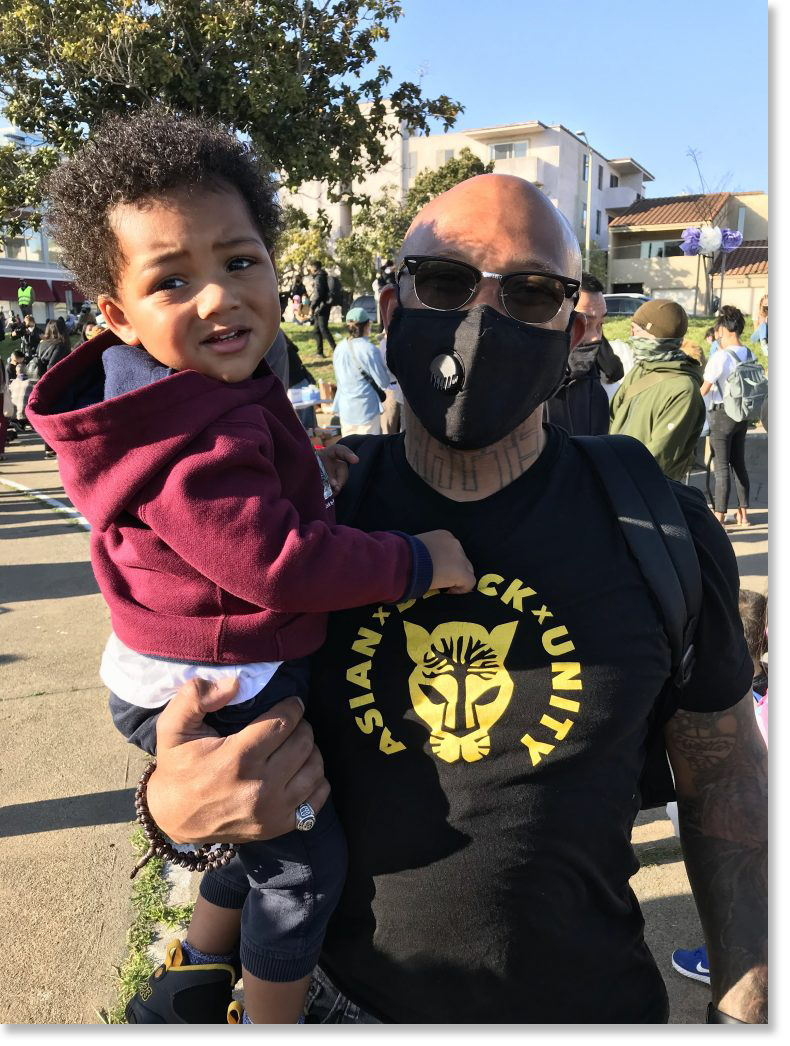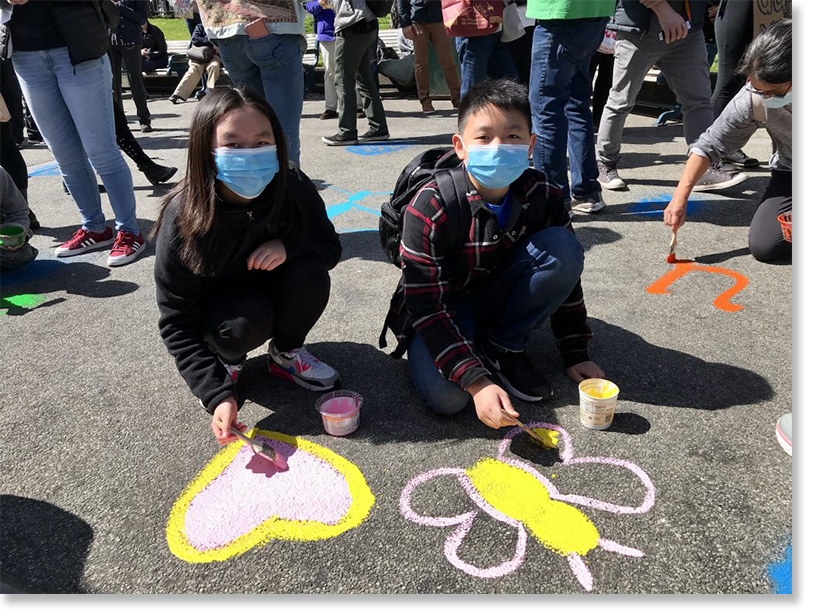|
Into the Soul of America by Eddie Wong |
|||||||||||||||||||||||||||||||||||||||||||||||||||
The news of the Atlanta spa killings hit on the West Coast on late Tuesday afternoon March 16. As news alerts of “multiple deaths at Asian spas” crawled across my computer screen, a sense of dread welled up and sank to the pit of my stomach. Many of us who have written about anti-Asian violence from the 1980s to the present, knew that some tragedy was bound to happen as President Trump fueled xenophobia and anti-Asian hate by blaming a zoonotic disease on China and by extension on all Asians. And now it had come to pass. By the late evening, it was clear that Robert Aaron Long, a 21-year-old white man, had murdered eight people. Six of the victims were Korean and Chinese women: Soon Chung Park,74; Hyun Jung Grant, 51; Yong Ae Yue, 63, Suncha Kim, 69; Xiaju Emily Tan,49; and Daoyou Feng, 44. Several of the elderly women were site managers at the spas. The other victims were Delaina Ashly Yaun Gonzalez, 33, who was getting a massage along with her husband Mario Gonzalez, and Paul Andre Michels, 54, who worked as an electrician and handyman at Young’s Asian Massage. Elcias Hernandez-Ortiz, who was outside of Young’s Asian Massage on his way to the check cashing business next door, was also shot by Long. He is still hospitalized. Police officials said Long told them that he had a sexual addiction and wanted to eliminate his temptation. When Long was arrested on the highway on Tuesday night, he was on his way to Florida to kill more people “connected to the porn industry.” As horrific as these murders truly were, there was more disgust and outrage to follow as Cherokee County Sheriff Jay Baker described the killer’s state of mind: “And he was pretty much fed up and had been, kind of, at the end of his rope. And yesterday was a really bad day for him, and this is what he did.” WTF. Sheriff Baker cast an empathetic tone to a murderer who had executed three Asian women with gunshots to the head and killed another Asian woman with multiple shots to her chest. Baker did not utter a single word of condolence to the victims who were executed based on their nationality and gender. It was later revealed that Baker had encouraged his Facebook followers in 2020 to buy T-shirts that read “Covid-19, Imported from Chy-na.” The Asian American Response These horrific murders sparked an outpouring of op-ed pieces from Asian American activists and heartfelt statements from Asian American celebrities. Some media outlets had already begun publishing stories about the surge of anti-Asian violence in the wake of the killings of Vicha Ratanapakdee, an 84 year old Thai man, who was slammed to the ground in San Francisco in January; Juanito Falcon, a 71 year old Filipino who was punched in the face in Phoenix, AZ (he died in the hospital on February 18); Ee Lee, a Hmong woman who was sexually assaulted and killed in Washington Park in Milwaukee in January; and Pak Ho, a 75 year old Chinese man who died of head injuries on March 18 after being assaulted in a residential neighborhood in Oakland, CA. The news outlets played chilling cell phone and surveillance video of dozens of verbal and physical assaults against Asian Americans. # StopAAPI Hate released a report on the same day of the killings that showed that 3,795 cases of anti-Asian hate had been submitted to the website since March 2020. The report revealed the nature of the hate: 68% verbal abuse, 20% shunning, and 11% physical assault with incidents occurring 2.3 times more for Asian American women. Numerous commentators pointed out that anti-Asian violence is not new and that it is part of a systematic exploitation and suppression of Asian Americans. Here’s a succinct articulation of this point by noted author/activist Helen Zia on the PBS News Hour. Comedian and writer Karen Chee manages to hit all the relevant points – this is a hate crime, this is racialized misogyny, this is white supremacy in action – in a winsome and compelling manner. She is among thousands of young Asian American women who are stepping up and calling out the names of our fallen, urging all people to take action, and encouraging us to keep our humanity intact as we righteously rage. In the aftermath of the killings, many people are writing about the roles stereotypes about Asian women have fed into violence against Asian American women. Author Nancy Wang Yuen pointed out that “the multiple wars with, and various occupations of, Asian countries have contributed to the exploitation and fetishization of Asian women.” Please read her full article “Atlanta spa shooting suspect’s ‘bad day’ defense and America’s sexualized racism problem." Irene Cho writes that “we see in white supremacy the belief that Asian women are subservient and obedient to do their bidding; to be controlled. Writing in the blog, “The Salt Collective,” Cho also addresses “the direct correlation that exists between white Christianity and white supremacy, along with the core tenets of patriarchy and misogyny that keep the two intertwined.” Please read her full article “Asian Fetishization IS white supremacy.” Red Canary Song, a grassroots Chinese massage parlor workers coalition based in Flushing, NYC, issued a statement that cautioned against victim shaming: “The women who were killed faced specific racialized gendered violence for being Asian women and massage workers. Whether or not they were actually sex workers or self-identified under that label, we know that as massage workers, they were subjected to sexualized violence stemming from the hatred of sex workers, Asian women, working class people, and immigrants.” Fighting Back – A Community Response Our rage and pain are compounded daily as the surge of anti-Asian violence continues. On the day after the Atlanta spa killings, two Asian American elders were assaulted within 30 minutes of each other at U.N. Plaza (7th and Market St) in San Francisco. Ngoc Pham, an 83-year-old Vietnamese man, was shopping at the Farmers’ Market when he was brutally knocked to the ground by Steven Jenkins. As Jenkins was being pursued by security guards, he punched Xiao Zhen Xie, a 76-year-old grandmother in the face. She found a stick on the ground and struck him in the face several times. Jenkins was arrested and hauled away in an ambulance. Mrs. Xie’s wounds will heal but she is very traumatized by the attack. On Sunday, March 21, Katie Hou was punched in the face at the Astor Place subway stop in New York City. She was on her way home from the anti-Asian violence demonstration when the attacker took her protest sign and stomped on it before punching her in the face. The woman’s seven-year-old young daughter witnessed the entire attack. She chased him, but the assailant got away. That same afternoon a 68-year-old Asian man was punched in the face at the Franklin-Varick Station in Manhattan. Bystanders attempted to pursue the the attacker but he escaped capture. Both assailants were arrested by the NYPD days later. Many of the attacks on Asian Americans are hard to deter as individuals are being hit from behind. This highlights the importance of “safety in numbers.” Predators may decide to pick other targets who appear vulnerable rather than tackle a group. However, there are times when you must venture out solo and having a weapon in your hand, ready to use, may be now required. It’s open season on Asian Americans and we cannot rely on others to protect us. We must protect ourselves with legal, non-lethal tools such as a fold-up umbrella, a tactical pen or flashlight, a rolled-up magazine, a set of keys, or anything else you find handy as Grandmother Xie did. Strike a blow and get away. Volunteer community patrols are now underway in New York, Los Angeles, San Jose, San Francisco and Oakland roughly following the models of the United Peace Collaborative in San Francisco Chinatown and Community Ambassadors in Oakland. By walking the streets in Koreatown, LA, Chinatowns in NY, SF, and Oakland, and San Jose Japantown, these volunteers provide a measure of safety to merchants and residents. Increased policing has also been implemented in Asian communities in several cities, but this brings with it many divided opinions. On one hand, people welcome any and all measures of increased safety. But police also have a history of harassing young people in the community. Despite principled differences among community members, we need to work together to safeguard the lives of our elders. At the heart of the issue is accountability. Our communities and people deserve to be safe, and the local government and police must be held accountable. Many elderly people in the Asian communities have justified fears of venturing out because the system has failed to protect them. We all have to work to build safe communities. Community activists have consistently raised the need for policies and resources that address the root causes of crime, poverty, disempowerment and health care. This is an important point to raise because we are witnessing the effects of caste and class in this onslaught of anti-Asian violence. Asian Americans of all economic and educational levels have faced verbal and physical abuse simply because they look Chinese. It doesn’t matter what kind of professional you are or how much money you have in the bank, to the racist bully you are just “the enemy, the scourge, the other.” But class is also at work when we look at where many of the assaults are taking place, namely in ethnic enclaves or working-class communities. When the pandemic fueled anxieties rose in March 2020, dozens upon dozens of Asian businesses were vandalized across the country. These businesses are located in predominantly working-class communities and not in wealthier neighborhoods. Similarly, many of the hate incidents are occurring in downtown areas and mixed-race residential communities. In other words, we’re seeing crimes in under-resourced communities where the lack of jobs, housing, education, and health care are at crisis levels. These tensions won’t diminish unless root causes are addressed. Fighting Back – Standing Up for Brothers and Sisters Several non-Asian friends and neighbors have written to me in the last few weeks expressing their dismay at the anti-Asian violence and concern for me and my family. A few have asked how they can be an ally. I tell them that just by caring about our communities is a form of allyship. I encourage them to learn more about our histories and communities for “Asian American” is a broad term that covers dozens of ethnicities with complex historical relationships to the U.S. A good place to start learning more is through the PBS Series “Asian Americans” which aired in 2019 and is now streaming for free at PBS.org. This multi-part series covers our historical roots in the U.S. and the evolution of our communities in the era of the Civil Rights Movement and ethnic empowerment. An ally is also someone who speaks out against white supremacy and works to dismantle its racist, misogynist, anti-Semitic scaffolding. When we work together and fight together, we become more than allies; we become brothers and sisters in the cause of building the Beloved Community. There is no stronger example of allyship than Brandon Haase, who observed a 26-year-old Filipina nurse being thrown to the ground at a Caltrans station in San Jose by Johan Strydon, who was hurling racist insults as he attempted to rape her. Bystanders yelled at the assailant, but Haase chased Strydon across the Caltrans parking lot and subdued him at the SAP Center station until police arrived. The nurse’s boyfriend who had dropped her off sped back to the scene and also chased Strydon. They put themselves at risk, but they did the right thing. Assailants need to know that we will fight back and defend ourselves. Many of the attacks happen very quickly and often bystanders can only render aid to the victim. Other bystanders do nothing perhaps out of fear or shock. This unabated onslaught requires that people do more, e.g., yell, scream, call for help, and physically intervene when an Asian American is being verbally or physically harassed. Hollaback is currently offering more bystander training sessions directed in support of Asian Americans. Sign up at Asian American Bystander Intervention. https://www.ihollaback.org/bystanderintervention/ Asian Americans are not standing alone in the face of hate. African Americans, whites, Latinx, indigenous peoples are coming out to the vigils and rallies. Black Lives Matter issued a “Stop Attacks Against Asian Americans” statement: “When we call for the eradication of white supremacy, we are saying that Asian Americans, and every other marginalized racial group, deserves to be freed from the violence, intimidation and fear. None of us are free until we all are.” The presence of African American supporters and BLM activists at the recent vigils and rallies is especially welcomed because expressions of Asian/Black and multinational solidarity are needed more than ever. Several of the attacks on Asian Americans have unfortunately been committed by African Americans and Asian progressives need to stand up against anti-Black sentiments in our communities that unfairly labels all African Americans as criminals. We need multinational unity, not further division. Taking the Long View on Ending Anti-Asian Violence The economic downturn in the auto industry due to competition from Japanese imports and the racist fearmongering that was fostered resulted in the June 19, 1982 killing of Vincent Chin in Detroit, MI. Anti-immigrant hatred led to the slayings of Raphanar Or, 9; Ram Chin, 8; Thuy Tran,6; Sokhim An, 6; and Oeun Lum,8, Southeast Asian students at Cleveland Elementary School in Stockton, CA on January 18, 1989 when a gunman raked his AK-47 automatic rifle across a school yard at noon recess. A white supremacist entered the Sikh Temple in Oak Creek, WS on Aug. 5, 2012 and gunned down Paramjit Kaur, Satwant Singh Kaleka, Prakash Singh, Sita Singh, Ranjit Singh and Suveg Singh. These were horrific crimes perpetrated on Asian Americans solely on the basis of race. We have seen similar murderous rampages by white supremacists in the Emmanuel AME Church killings in Charleston, SC (2015), the Tree of Life synagogue killings, (2018), and the El Paso Walmart shooting (2019). In these cases as in the Atlanta spa killings, easy access to guns without background checks on the shooters led to tragic outcomes. Today’s wave of murders, assaults and verbal abuse is on an unprecedented scale for Asian Americans. According to the Center for the Study of Hate and Extremism at California State University, San Bernardino, hate crimes against Asian Americans as reported to 16 of the country’s largest cities showed a 149% increase in 2020. Each day brings new reports of someone being beaten or harassed. There doesn’t seem to be an end in sight because the high levels of anger, resentment and anxiety that stem from the pandemic continue to fuel the attacks. White supremacists and racists continue to promote anti-Asian messages online. Davey Alba, New York Times reporter wrote on March 19: “In December, slurs about Asians and the term “Kung Flu” rose by 65 percent on websites and apps like Telegram, 4chan and The Donald, compared with the monthly average mentions from the previous 11 months on the same platforms, according to the Network Contagion Research Institute. The activity remained high in January and last month.” Public declarations against anti-Asian violence from President Biden and Vice President Harris help set a national tone that is reinforced at the local level by elected officials and community leaders. But nothing is more powerful than the acts of everyday people who have come out by the thousands to attend rallies this past weekend. People of good will must rally together to set anti-racist and anti-misogynist standards. We have before us the daunting task of dismantle white supremacy and racialized misogyny. Scholar Ibram X. Kendi, author of Stamped from the Beginning: The Definitive History of Racist Ideas in America and How to be an Anti-Racist, spoke with USA Today in February 2021 about the goals of the new Center for Antiracist Research at Boston University. “Racist research asks the question, What’s wrong with people? What’s wrong with those racial groups,” said Kendi. “Contrast that with antiracist research, which asks questions like, What’s wrong with policies? What’s wrong with conditions? What’s wrong with systems and structures.” He added, “Why can’t we be calling for immediate equality? Why can’t we be thinking that big?” Kendi’s analysis means upending the status quo. In a December 2, 2020 online conversation with Yale Alumni Association, Kendi said, “In order to be anti-racist, we have to express ideas of racial equality. We have to support policies that are leading to racial equity. We have to challenge ideas that there’s something wrong with Latinx people, we have to challenge policies that are dispossessing Native land.” Pursuing these ideals will require gaining progressive political power. Legislative measures and economic reforms come through having antiracists enact these policies. Needless to say, this is a long process of organizing, policy development and winning popular support. But nothing will deter the waves of racialized violence until we work together on bold systemic solutions and radical transformation of the major institutions that constitute civic life. At the end of Angela Davis’ talk to Boston University students in February 2019, she was asked if problems like racism, healthcare and economic inequality could ever be resolved. “Sometimes we have to pause and say that things don’t have to be the way they are and to imagine a different time when education is free,” said Davis. “Healthcare should be free for everyone ... It’s about the monopolization of the wealth that is produced on this planet. So, yeah, that means we have a long struggle ahead of us.” Meanwhile, our anger continues to burn. Our outrage at anti-Asian violence unslackened. And like a fire that burns through the long, dark night, the flickering light casts out the shadows, the shackles of the model minority myth, and the canard of being the obedient middleman in a racial cauldron that is America. I ended my 1983 essay on the murder of Vincent Chin (East Wind Magazine Spring/Summer 1983) with these words: “What can we do about the murder of Vincent Chin? We mourn for his family for as they have lost a son, we have lost a brother. ... The murder of Vincent Chin and the perversion of justice in Judge Kaufman’s court (the killers were given three years’ probation and a $3,000 fine) lays bare a fundamental reality of being Asian in the U.S. As long as one of us can be murdered, his/our rights trampled, then none of us are free. There is struggle ahead. There are debts to be settled, dues to be paid. There are battles to be won.” We seem to be fighting the same battle over and over and that is precisely so because the system that dominates us has mutated and become more entrenched. Inequality and misogyny are structured into capitalist relations and a deep-rooted settler colonialist culture. Stopping Asian Hate means breaking free of those chains. So let the fires burn in our hearts and into the minds of all those around us. We are present. We are visible. We demand to be treated with the full rights all human beings possess. And we will fight with other brothers and sisters who share the same vision for a world free of hate and full of love and justice. This is a fight for the soul of America. Author’s Bio: Eddie Wong has been an activist and media artist in the Asian American Movement since 1968. He is the editor/publisher of East Wind Ezine. Author’s Bio: Eddie Wong is the editor/publisher of East Wind Ezine.
|
|||||||||||||||||||||||||||||||||||||||||||||||||||
|
Published in In Motion Magazine - April 7, 2021.
|
|||||||||||||||||||||||||||||||||||||||||||||||||||
If you have any thoughts on this or would like to contribute to an ongoing discussion in the  What is New? || Affirmative Action || Art Changes || Autonomy: Chiapas - California || Community Images || Education Rights || E-mail, Opinions and Discussion || En español || Essays from Ireland || Global Eyes || Healthcare || Human Rights/Civil Rights || Piri Thomas || Photo of the Week || QA: Interviews || Region || Rural America || Search || Donate || To be notified of new articles || Survey || In Motion Magazine's Store || In Motion Magazine Staff || In Unity Book of Photos || Links Around The World NPC Productions Copyright © 1995-2021 NPC Productions as a compilation. All Rights Reserved. |


